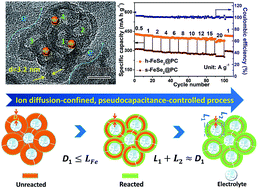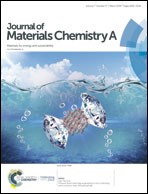Cellular carbon-wrapped FeSe2 nanocavities with ultrathin walls and multiple rooms for ion diffusion-confined ultrafast sodium storage†
Abstract
Sodium-ion batteries (SIBs) with high energy/power density have been in urgent demand for various power applications. Upgrading the electrochemical dynamics of electrode materials is crucial to achieve this goal. Herein, we exhibit delicately synthesized cellular carbon-wrapped FeSe2 nanocavities (h-FeSe2@PC) with sub-5 nm ultrathin walls and multiple rooms for ultrafast sodium storage. Unlike with the conventional interphase Kirkendall effect, the multi-room FeSe2 nanocavities were formed via an exotic stress-induced cracking–hollowing reassembly mechanism. Benefiting from their unique multi-hierarchy, more than 93% pseudocapacitive capacity contribution was recognized in an h-FeSe2@PC anode, featuring ultrafast dynamics. As a result, h-FeSe2@PC displayed an extremely low-decay (9.5%) rate capability, ultrastable cyclability (over 2000 loops with 98.5% capacity retention), and high energy/power densities (670.7 W h kg−1/35.3 kW kg−1 at 20 A g−1). The results of multiple analyses and comparisons showed that the dynamics-promoted superior performance was correlated almost completely to the applied FeSe2 in h-FeSe2@PC by shortening the Na+-diffusion length to near the accessible limit (<10 nm) and to the fast electron transfer ensured by the cellular carbon. The exhibited dynamics-oriented materials design could open up an avenue to aid the further development of high-performance electrodes.



 Please wait while we load your content...
Please wait while we load your content...